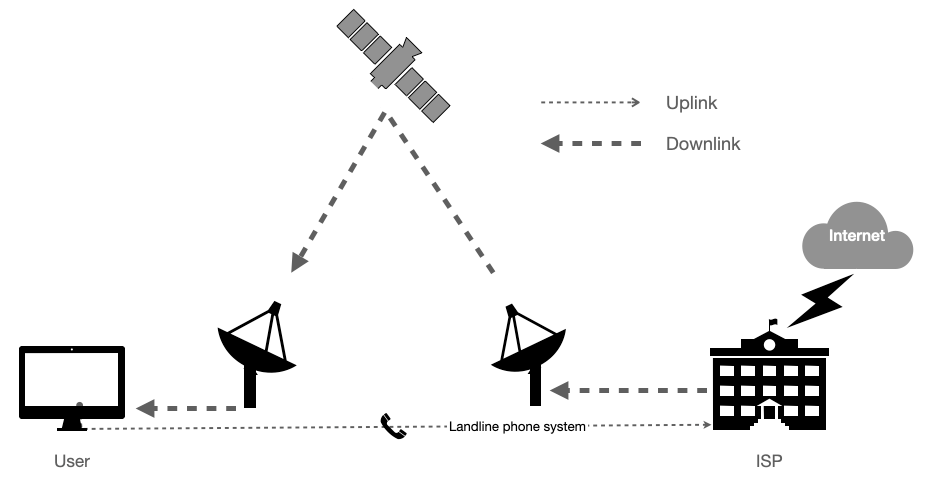Signals from Above
Part II in a series about the promise and perils of Starlink and planetary-scale internet service providers

I understand that part of today's press conference is being relayed by the Telstar communications satellite to viewers across the Atlantic and that this is another indication of the extraordinary world in which we live. This satellite must be high enough to carry messages from both sides of the world, which is of course a very essential requirement for peace, and I think this understanding which will inevitably come from the speedy communications is bound to increase the well-being and security of all people, here and those across the oceans..
—President John F Kennedy, July 23, 1962.
The history of commercial satellite-based communications dates to the Kennedy era when NASA launched AT&T's Telstar One on July 10, 1962. This satellite was in a low-earth orbit (LEO) and by the standards of the day it was extremely advanced. Telstar orbited around the earth every two hours and thirty-seven minutes. This orbital period provided a short window for operation, but the device successfully transmitted phone calls, faxes, and live television between countries and continents. While Telstar lasted less than a year, it proved that space-based communications systems were viable enterprises. (It is still in orbit, but ceased operations, partially due to its electronics being damaged by US nuclear tests in space.)
Within a few years rockets could lift payloads into higher orbits and satellite electronics had improved dramatically. These developments made it possible to place communications satellites in much higher geosynchronous (GEO) or geostationary orbits. [Note: I will use the term geosynchronous in this text to cover both geosynchronous and geostationary orbits. They are technically different but for our purposes have the same functionality: they can provide consistent long-term coverage of a particular area (learn more here).
Geosynchronous orbits are located very high up (22,236 miles or 35,786 km), which allows satellites to stay over the same general spot on the planet for long periods, providing consistent service to the ground below. The first commercial satellite placed in a GEO orbit was Intelsat I which was launched in 1965. Geosynchronous satellites opened up entirely new applications, including satellite television—an important "one-to-many" type of communication.

In the mid-1990s Hughes Network Systems started to use its GEO satellites to sell internet access to consumers and businesses. Because communications satellites in GEO orbit are so large, costly, and expensive to launch, they get upgraded infrequently. A GEO satellite must perform for decades in order to recover expenses and generate a profit. In order to re-purpose existing satellites, Hughes used a little bit of a work-around (what us techies would call a kludge) with its early service offerings.
While the downlink to the consumer came via a satellite relay to the customer's dish, the uplink was through an analog phone line. For most applications, such as browsing the web or downloading music, the amount of data going "up" is much smaller than the amount of data coming down. For example, the request to load a webpage takes very little data, whereas the webpage may take a lot of data. (See this page for details about how early satellite-delivered Internet separated the uplink and downlink signals.)
This kludge allowed Hughes to re-task their satellite technology that had originally been designed for one-to-many communications, instead of deploying new technology. It also reduced the complexity of the system. There was no need for a transmitter at the user's site, and the satellite didn't need to be capable of receiving information from users but just relaying information "down" to them. Decoders in the consumer's receiver ensured that they received just the information that they requested.
Subsequent upgrades eliminated the need for a dedicated phone line, and the uplink and downlink are all made via satellite (however, uplink bandwidth remains lower than the downlink).
While GEO satellites allow for constant coverage over a large area, the great distance from the earth to the satellite is a significant drawback since it dramatically increases the latency of the service compared to terrestrial-based networks. Latency is the time between when a packet leaves its source and when it arrives at its destination. The time to get from point A to point B. Latency can be affected by several factors, including all the networks, switches, and routers that a packet has to traverse to get from point A to point B. A high latency network is a poor network.
Since there was no internet in space, the satellite is just a relay between the customer and a ground station that connects to the land-based internet. Just one leg of this relay can take 120 milliseconds, and that is assuming ideal conditions where signals are processed immediately.
Now consider that when a user of such a system wants to load a webpage, the process will require four trips between earth and space: Trip 1 users request is sent to satellite; Trip 2 satellite relays the request to a ground station; Trip 3 ground station sends webpage to satellite; and Trip 4 satellite relays to the user. It takes over half a second for the first 1 or 0 to get to the user under the ideal conditions. The latency of an internet connection delivered by a geosynchronous satellite can be 10-15 times that of a land-based system.
The high latency and low-speed uplink of this delivery technology also means that real-time applications (zoom, WhatsApp voice calls) are pretty much out of the question.
As such, consumers generally will only choose a GEO satellite service for internet if there are no other viable options.
Satellite Constellations
Satellites in LEO or Medium Earth Orbit (MEO) are much closer to the earth and therefore serve a much smaller coverage area than those in GEO orbit. LEO satellites must move quickly to stay in orbit, so the area they can communicate with changes by the second. As such, LEOs were historically used for observation and data collection, not for applications requiring continuous communications or broadcast.
The idea of using a constellation of LEO satellites was first worked out in the 1980s as part of the Strategic Defense Initiative (SDI), as a way to keep anti-missile weapons in space and ready to spring into action when an offensive rocket was launched. The main objective of these early designs was to allow satellites to communicate and coordinate with each other, not for delivering services to the earth.
In the late 1980s, three engineers at Motorola realized that if satellites in low-earth orbit were organized in overlapping polar orbits, a data connection to a ground-based user could be handed off from one satellite to another as the satellite moved out of range. This is similar to how a cellphone call is handed off from one tower to another as a caller travels along the highway, except in this case, the "tower" is moving overhead, and the user is stationary (relatively). Such a system would provide global coverage and the lower orbit would substantially reduce the latency, making real-time data and voice applications possible. Satellites in LEO constellations can decrease communications latency by an order of magnitude compared to GEO satellites. In addition, the lower altitude above the earth meant that less power would be required to transmit to the network, allowing for handsets and modems that were portable and convenient to use.1
Motorola's original model required seventy-seven satellites. Seventy-seven is the atomic number of Iridium, so Motorola named its service after the element. It turns out that using sixty-six satellites would do the job (11 satellites in 6 different polar orbits), but the Iridium name stuck.

The design for the Iridium network was ingenious. Iridium satellites could act as a relay from a user's terminal to a ground station but could also relay voice and data signals from one satellite to another. This way, data and voice calls could be routed through the network without the need for lots of ground stations worldwide. A call between one Iridium user and another would not have to connect to a terrestrial network. Iridium was indeed a network in space. As such, the Iridium network could function with just eleven ground stations.

Motorola figured that the killer app2 for Iridium would be phones and pagers for jet-setting executives. They rolled out a one-pound $3,000 handset that allowed these decision-makers to make and receive calls from any place in the world. However, jet-setting executives tended to set their jets down in large cities that had lots of amenities and where the deployment of land-based cellular and paging services was proceeding rapidly as more consumers subscribed to mobile services.
After it became clear that Iridium would not be a commercial success, Motorola attempted to kill its darling and deorbit the satellites to end the project. (LEO sats are often deorbited by using small positioning thrusters to push the satellite toward the earth and change its orientation to increase atmospheric drag.) Numerous objections were made by the Department of Defense and Central Intelligence Agency, and through the brilliant business maneuvering of one man—Dan Colussy—the Iridium network was saved, and the Iridium corporation was essentially spun out from Motorola. Curious readers can read more about this in the excellent book Eccentric Orbits: The Iridium Story by John Bloom. Iridium eventually found a profitable niche in providing low-bandwidth data services to industrial clients and the shipping industry.3
Satellite operators mainly focused on industrial, military, and governmental customers, who could pay the high costs needed to make a communications satellite company profitable. Other companies developed similar constellations to deliver global data services to governments and industries.
Several decades after Iridium launched, the economics and technology had changed dramatically, and a new generation of satellite constellations entered the market: The Mega Constellation.
Next Week: Reuse, reuse, reuse.
ICYMI, last week’s post:
Continue the Conversation
Please join the conversation in the Substack chat (linked below), by commenting, or simply replying to this email. I would love to hear your thoughts.
Globalstar started around the same time, offering similar services.
A killer app is a feature that is so valued that people will pay for the hardware to have that one feature. When personal computers started, the electronic spreadsheet, namely VisiCalc, was so valued by accountants and financial analysts that they would pay for the computer, monitor, and printer just to get that one application.
Iridium has since upgraded their constellation of satellites.








I remember when, on a trans-Pacific phone call, only one person could talk at a time. There was no divided highway, so to speak.